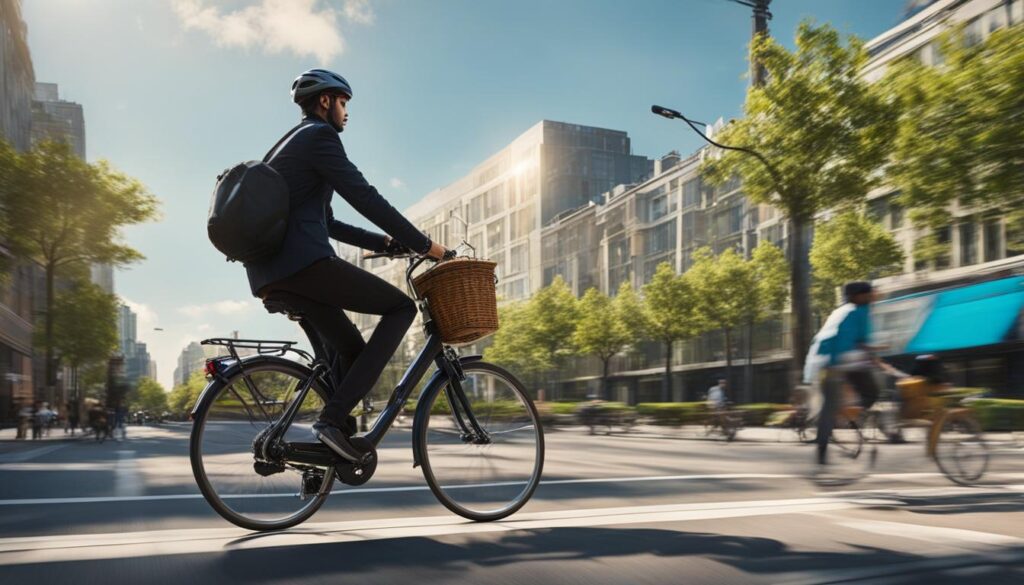Welcome to the world of bicycle advocacy – a movement that empowers cyclists to create a sustainable future. As you may be aware, the world is facing an environmental crisis, and transportation is a significant contributor to it. But, imagine a future where green commuting is the norm, where bicycle culture is promoted, and where cyclists enjoy safe and convenient routes to navigate our cities, towns, and communities. This is where bicycle advocacy comes in.
Bicycle advocacy aims to promote cycling culture, green commuting, and sustainable transportation practices. By supporting and advocating for cycling infrastructure development, bicycle education, and increased bike-friendly policies, we can create a world where cyclists and sustainable future coexist. The benefits of this lifestyle are many, and it’s time to seize them.
Key Takeaways:
- Bicycle advocacy empowers cyclists to shape a sustainable future
- Promoting cycling culture is an essential part of creating a green commuting environment
- Bicycle infrastructure development is crucial to sustainable urban planning
- Cycling reduces carbon emissions and improves air quality
- Green commuting has numerous benefits, including improved physical health and reduced traffic congestion
The Environmental Impact of Cycling: Building a Sustainable Urban Landscape
Cycling is one of the most sustainable modes of transportation. As cities strive for environmentally responsible urban development, bicycling is emerging as a key component of sustainable infrastructure. By integrating bicycle infrastructure into sustainable urban planning, we can reduce carbon emissions, improve air quality, and create safer cycling routes.
According to recent studies, a single person switching to cycling from driving could reduce their carbon emissions by up to 1.3 tons per year. Imagine the impact if an entire city were to transition to cycling as a primary mode of transportation!
Bicycle infrastructure, such as dedicated bike lanes and bike parking, promotes safer and more efficient cycling. The creation of bike-friendly cities also contributes to healthier lifestyles, improved air quality, and a reduced dependency on fossil fuels. Sustainable urban planning recognizes that bicycling is more than just transportation – it’s a lifestyle, contributing to the health and happiness of communities.
“A city that is ‘good for cycling’ is a city where cycling is accessible and safe for people of all ages and abilities.” – Janette Sadik-Khan, Former NYC Transportation Commissioner
As the environmental impact of cycling continues to be recognized, it’s important for city planners to prioritize bicycle infrastructure in sustainable urban planning. By doing so, we can ensure a greener and healthier future for generations to come.
Green Commuting: Revolutionizing Transportation for a Greener World

If you want to contribute to a sustainable future, green commuting through eco-friendly transportation is an excellent way to start. Choosing the bicycle as your primary mode of transportation can have multiple advantages for both you and the environment.
- Improved physical health: Cycling is a low-impact exercise that is excellent for building cardiovascular endurance, toning muscles, and keeping you fit.
- Reduced traffic congestion: Cities are becoming increasingly crowded with cars, and this excess traffic has serious consequences, such as increased air pollution and public health problems. By cycling instead of driving, you help reduce traffic congestion and its negative impacts on your community.
- Minimized reliance on fossil fuels: Fossil fuels are a finite resource, and there is already a scarcity of such fuels. By choosing to cycle, you are reducing your contribution to the demand for fossil fuels. This contributes to a cleaner and more efficient transportation system.
Cycling, however, requires that appropriate bicycle infrastructure must be put in place to ensure the safety of all road users. This infrastructure includes bike lanes, designated crosswalks, and bike parking facilities. Governments, communities, and urban planners must work together to prioritize bicycle infrastructures, making it a priority in urban planning for a sustainable future.
“Green commuting is not only good for the environment, but it’s also good for your health and your wallet.” – Christine Gregoire
Conclusion
Congratulations on reaching the end of this article! As a cycling enthusiast, you have the power to shape a sustainable future through bicycle advocacy. By promoting green commuting and advocating for bicycle infrastructure in sustainable urban planning, we can work towards a more eco-friendly transportation system.
Remember, every time you choose to bike instead of drive, you are taking a step towards a greener world. Join the movement and inspire others to do the same. Together, we can make a difference in creating a more sustainable future for all.
FAQ
How can bicycle advocacy empower cyclists to shape a sustainable future?
Bicycle advocacy plays a crucial role in empowering cyclists to create a sustainable future by promoting green commuting and fostering a cycling culture. It raises awareness about the benefits of cycling as an eco-friendly transportation option and advocates for improved bicycle infrastructure and sustainable urban planning.
What is the environmental impact of cycling?
Cycling has a positive environmental impact as it reduces carbon emissions, improves air quality, and helps create a sustainable urban landscape. By choosing cycling over cars or public transportation, cyclists contribute to the reduction of greenhouse gas emissions and the overall improvement of the environment.
How does green commuting revolutionize transportation for a greener world?
Green commuting, which involves choosing eco-friendly transportation options like cycling, revolutionizes transportation by reducing reliance on fossil fuels and minimizing traffic congestion. It promotes a healthier lifestyle, reduces carbon footprint, and contributes to a greener and more sustainable future.
Why is bicycle advocacy important?
Bicycle advocacy is important because it helps promote and support the interests of cyclists. It advocates for better bicycle infrastructure, including dedicated lanes and parking facilities, and raises awareness about the benefits of cycling for individuals and the environment. Bicycle advocacy plays a vital role in shaping a sustainable future and building a cycling-friendly culture.


